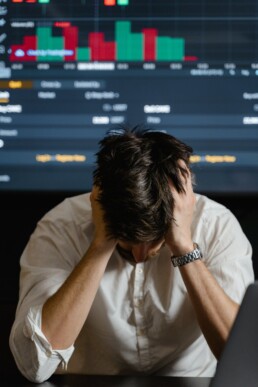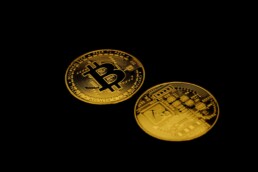Why Investing is important.
Why people invest in the financial markets?
The reason is only one.
To have more money.
In fact, investing is neither more nor less like a job, using our money to have an economic return.
Not to be confused with the term speculation, which refers to a short term view, investment refers to the long term and has a different forms of investment instruments.
These tools are created to ensure that companies raise money for their activities, money that is raised by selling debt such as bonds or a small part of the company, such as shares.
Returns are never guaranteed given the risk inherent in investing.
There are no zero risk investments, don't believe anyone who tells you such a thing.
In fact, you can lose everything, because you have to remember that the higher the risk, the greater the return.
Various techniques are used to lower risk, such as diversification which applies to unrelated investments.
Investing serves to achieve personal and family financial goals such as the possibility of having more money for goods and services, to be able to afford a dream home or vacation, or to have economic certainty when you retire.
Starting early means having a longer period of time to be able to accumulate, also thanks to compound interest.
How to get started with bitcoins!
what are the steps to get to know Bitcoin?
Step n1 Education
You have to understand the basics of bitcoin and what revolves around it, studying our guide and seeing our videos is a good starting point.
You have to understand why people appreciate this new technology, what gives it value and why, what is behind it and what are the ideas that led to its creation.
Step n1 is useful but not fundamental, in the sense that you can buy bitcoins even without knowing anything about it.
The second step is to gain experience with a purchase.
Create a wallet, sign up for an exchange and start moving your bitcoins.
Get experience through small transactions and expect to spend 100 euros that you can consider lost.
Then try to turn some of these bitcoins into ethereum and experience that too.
The third step will be to stay updated on the technology and the market.
And always follow us.
The uncertainty of the investment
Today we are going to talk about the aspects behind investments and their psychology.
We are facing the uncertainty about investing in the financial world.
The human being is in the perennial search for security thanks to a natural genetic repulse to risk to make us survive.
Risk aversion in an environment where we can be killed by beasts or adverse climatic conditions is what allowed us to survive thousands of years ago.
Many people have an innate adversion to losses.
Try to think of losing 20 euros. In this case the pain will be greater than the pleasure of having earned the same 20 euros.
This means that these people are totally opposed to certain practices that allow them to increase their portfolio .
In fact, to have an interesting economic return you have to take risks, since risk is the fuel of the potential profit.
It is also true that some zero-risk investments still exist such as bank accounts but which yield practically are below zero.
And these are not at zero risk since there is the risk of bank failure.
Therefore, it is necessary to manage the investment risk.
In the financial world, risk means exposure to the possible loss of money, or the possibility that your investments will drop in value compared to the purchase cost.
The amount of risk we are willing to expose ourselves depends on various factors like volatility.
Volatility indicates an indecision on the price on the part of sellers and buyers, certainly equates to a greater risk that can be justified by the greater possible gain.
Precisely to maximize our earnings and to analyze the risk to which we are exposed, an analysis of possible events that could affect our investments must be made, a sort of exercise to manage some risks to which we may be exposed.
Among the risks that we can easily recognize are:
a rise or fall in interest rates by the central bank, affecting corporate loans;
a credit risk, with debtors unable to pay their obligations;
a sudden inflationary push in a specific country or worldwide;
A possible country risk, as happened with Greece or Argentina;
These last two risks can be placed in a large group that we can call
market risk or systematic risk.
This is a type of risk that can affect all companies operating in a specific country or market.
We are talking about a recession, which destroys all the spending power of the population or an environmental problem that jeopardizes a specific industry, such as a disease that attacks plants destroying them all over the world.
Going more into the details of a specific market we can then talk about the specific risk of a company, like Enron in the United States.
This type of risk refers to a specific company in a national or international market and can be caused by huge scandals, or by the appearance of new international competitors on the internal market or by a new legislative change that worsens our market situation.
Remember that every investment is under this kind of risk and that systematic risk is difficult to predict in the future while specific risk can be eliminated through diversification.
But then there are assets that are not subject to risk, those safe havens where everyone can take refuge.
Yes, they exist and generally the greatest exponent is gold.
However, it should be remembered that gold also has price fluctuations and that in the event of a crisis it could have a certain decline. But here we need to understand how much the drop is, for example if gold falls by 10% in a market that dives into minus 60 or 70% ...
Let's move on to another point of view, moving from investment to investor.
The psychology and preparation of those who put money into any investments are much more important than people think. It is necessary to understand the different risk tolerance of the different people who approach the market.
This tolerance is mainly given by two factors which are the predisposition to risk influenced by one's personality and personal financial culture, to which must be added the ability to manage emotions and the fear of losing one's money.
Managing anxiety and maintaining clarity to better manage the situation are two very important characteristics.
Think what could happen if we panicked at every slightest downtrend or wanted to take home every little profit.
Other factors that can make this situation worse, is your relative financial situation and in which time frame you are investing for your life. Maybe that descent won't change your life, but if you've used all your money on a single asset, it starts to be different.
Financial availability and your working salary are two factors that can make you feel better, combined with a long-term vision.
If we think of a personal safety net like a bank account with a good amount of money and a job with a good salary, a loss of 20% is something that we can expect. A short-term view means that risks and loss tolerance are approached differently.
The risks are generally in a short period of time, and the markets generally recover from the crisis by making new highs in a period of time that is not so long.
One last note aside, the age of the investor is also important. An elderly person is unlikely to get involved with particularly dangerous assets.
Do not focus only on volatility risk, but on real risks, on those things that are too good to be true and try to always have a long-term view.
Risk is necessary, it can be controlled but it cannot be avoided.
Learn more about safety here.
The difference between economy and finance
Today we are going to learn what is the difference between economy and finance in our society.
It is a difference that has been thinning lately but which is still present.
We have to start from a well-defined initial assumption, the stock market does not measure the same thing as the economy, they are two connected entities but they represent two separate things.
The financial markets as a whole represent all the stock exchanges in the world and their lists or indices such as the Nasdaq in the United States.
On these indices, stocks, bonds and other financial instruments of that specific country are bought and sold.
The market goes up when the value goes up, and goes down when the value goes down.
So the indices give us an idea of how the market is doing.
If the stock market lists are contained and easily calculated, this is not the case for the economy.
In fact, the economy is much more extensive and difficult to calculate.
A value like GDP ideally indicates a country's spending mass, but investments, exports, imports, household consumption, their debt burden and government spending must also be considered. We are talking about a huge number of variables.
Back to the stock market, this gives us an idea only of the trend of the companies that are listed on that list.
We are talking about a vision that we can define as distorted or very limited.
These listed companies are actually part of the country's economy but there are also a lot of companies that are not listed and are themselves part of the economy.
Most companies in a country are not listed, for various reasons.
A possible collapse of the economy would affect them all in a more or less serious way while a collapse of the stock market should not affect them directly, or rather it could affect them indirectly with regard to any listed partners or suppliers.
In fact, if we change our point of view we will see that most of the people who have a job are part of the economy, but not all of these workers have money invested in the stock market, so a decline in stock has no direct impact on the citizen while a collapse of the economy does.
However, it should always be remembered that the stock market is still important since it has an indirect impact on the economy and on citizens' portfolios. In fact, the value on the stock market is reflected in the banking relationships of companies.
Companies considered of little value on the market, in addition to struggling to survive the competition, cannot access loans and therefore funds for their business.
Returning to the stock market, it should be specified that it may or may not push the real economy.
A rising stock market will give investors a greater propensity to spend, an expense that will be inserted into the real economy circle by increasing wealth. This wealth will allow companies to grow, increasing their staff and their reference markets.
Collect more capital on the market that can be invested in the company itself, without also considering the "wealth effect" given by a rising equity portfolio.
Obviously, all of this is reversed if we have a collapsing stock market, with a slowdown in the real economy.
But this influence between the financial market and the economy is real, the trend of the economy also influences the financial market.
those who work on the stock market base their sales and purchase decisions on what they see happening to the economy and its players in the field.
These two entities are closely linked but not necessarily have to move in the same direction, this is because they focus on two different periods of time.
The financial market has a vision towards the future, those who buy and sell shares do so by thinking about what will happen and how the economy will go in the coming months or years.
So the stock market will grow if there is a belief that the economic world of tomorrow will be better than today.
You can take positions today that will last for years or decades.
The indicators of the economy instead look to the past, that is, they are a snapshot of what it is today, but more precisely yesterday.
Economic indicators can indicate a contraction and at the same time the stock market can grow because investors see a possible recovery of the global economy on the horizon.
Remember that stock market prices reflect investor expectations.
Expectations and not what will happen in the future.
The entities of economics and financial markets are two entities with major complications, which cannot be solved in simple numbers. Always have a balanced approach when investing your money.
ESG Investing
Today we learn how to invest ethically or what it means ESG
As we know, our society is constantly evolving.
Investments need an evolution, in this case giving greater attention to what is sustainable for the planet.
In fact, until now there was no particular attention in investments regarding the ethics followed by companies and the only parameter concerned was the mere profit of money.
Investments defined ESG as Environmental, Social, Governance investing
This definition applies to companies that are in line with the new perception of the modern public attention to social and ecological problems of the planet.
These companies are the ones to keep an eye on and to own if you want to create an ESG portfolio, or ethical portfolio.
Going to see deeply the ESG acronym, this means:
E as Environmental, we consider the pollution produced by the company, energy consumption and the green or non-green footprint that the company itself has, for example in the production of carbon dioxide.
S stands for Social, which includes respect for the rights of the various communities, the provision of fair salaries to all employees without discrimination, aid to minorities and social management in the workplace.
G stands for Governance, which is the management of diversity within the working community.
Now, how can we make sure that we have a state-of-the-art portfolio?
We have two methods, with some differences to apply to our studies on possible assets to buy.
The first method, which we can define as "negative" or "removal", involves our decision to remove from our possible purchasing choices those companies that have areas of interest such as tobacco, weapons, gambling, or are implied in fraud or minority mismanagement stories.
Once this selection is complete, the remaining companies will be our possible purchasing choices without further in-depth studies in this regard.
Otherwise we can use another method that we can define as "positive" or "inclusion".
That is, we seek only actions that give local and environmental benefits or follow initiatives dedicated to improving the world and gradually eliminating their impact on the environment through, for example, the use of only renewable or sustainable forms of energy such as solar and wind energy.
Now chosen the method, you as a small investor or an ESG fund manager, after having roughed up the list of buyable shares, will make a purchase choice based on other technical parameters.
The ESG method is not a standardized system at the moment, in fact it has different criteria and different points of view based on the manager's or purchaser's thinking.
We might be surprised to find some fossil fuel companies considered ESG compliant, this is because they are among the various companies in the segment the most efficient on many parameters such as their excellent impact on the economy of the community where they operate.
Remember that the ESG scores assigned to the various companies can vary a lot due to the difficulty of analysis.
Companies have many partners, they have long and complicated supply chains and everything behind it is difficult to analyze in depth.
This leads us to talk about a phenomenon, like greenwashing or the cleaning of the reports created by the companies themselves.
This implies creating green initiatives that serve exclusively to have a better ESG score but that in reality do not impact on pollution or improve the life of the community.
There may even be ESG scam profiles, in which reports are artfully created for companies that actually have no ecological target.
In short, you would invest in a company that cuddles unicorns on paper, but which in reality unloads the used oil from their vans and truck into the river behind the shed.
So beware of gray areas.
Currently, the ESG profile has become a bit of an hype, so funds and ETFs have been created made exclusively by ESG companies.
This solves the problem of choosing but at a higher economic cost. On the other hand, fashions always cost a little.
Also be aware that ESG criteria limit your diversification, creating greater investment risk.
In short, we find ourselves at the end of a clash between ethical investing versus traditional investing
However, what concerns the ESG method can lead companies to make changes to their production and management methods, even leading them to be ahead of the legislation that will change in the future.
Customers themselves are also more likely to buy ethical products when they know about them.
How to choose an Exchange - Rookies
Today we see how to choose an exchange for buying and selling our cryptocurrencies.
First of all we must understand at what point of our path we are, this guide wants to be a sort of how to for complete newbies.
There are some basic things to know and consider before choosing your trusted exchange.
Let's start with the idea that all large exchanges tend to be more or less equivalent in the service you will use at the beginning, but moving forward you will obviously also notice substantial differences.
One of the first differences that we can check is the trading location of the exchange and consequently which customers the exchange accepts, based on their country of origin or residence.
For example, US clients are not always accepted on some Asian exchanges.
Another difference lies in the methods of payment of crypto or, to better define it, in the method of entry into this world.
In fact, not all exchanges accept fiat money deposits.
Many exchanges only accept stable coins and not all of them. In this case you would find yourself with some euros on your hands without knowing how to get them to your exchange and you would have to find an alternative method, such as switching from another exchange that accepts fiat money.
Then the usage fees must be considered.
We've already talked about what fees are, and how they can destroy your profitability.
The more expensive an exchange is, the harder it will be to make sure your trading is positive.
The KYC or customer verification system is another thing to consider.
There are exchanges that do not allow you to operate without your documents while others give you an operating or withdrawal limit.
And then lastly, the number and which coins are listed on the exchange.
Choosing an exchange with a limited number of coin is not a long-term choice, unless you are a specialist of those specific coins.
Instead, an exchange with a good number of coins, to which more are added, will allow you to increase your future earnings.
Learn more about safety here.
How to buy a cryptocurrency - Rookies Step
Today we are going to see how to buy a cryptocurrency in 3 simple steps.
phase 1 - Research:
Before doing anything you have to find out what you want to buy.
Which seems trivial, but it's not so easy to find because the crypto market offers a disproportionate number of coins.
First of all we need to understand if we want to buy a coins with a glorious past or a coins that have just come out on the market.
We need to make this research, which can also be based on suggestions given by the media or friends.
Be careful in this case not to be fooled by possible scams.
Analyze the situation of the coin on a graphical level and everything that revolves around it.
phase 2 - SAFETY
Once you have chosen the coin you want to buy, the first thing to do is find a secure wallet and create it.
Learn more about safety here.
step 3 - buy the coin
Open the exchange and press the BUY button.
Now some recommendations
Always do extensive research on the coin you are analyzing and if someone has suggested it to you, try to understand if it is a disinterested suggestion or not.
Obviously NEVER follow the hype.
The hype invariably leads to entering at inflated prices and then losing a lot of money. Enjoy the hype by standing at the window.
Remember that wallets are programs to hold your coins so pay attention to the different types of wallets and different types of addresses.
If you get the wrong address you have lost your coins.
Bitcoin halving in May 2020
The bitcoin halving is an event that occurs every about 4 years and halves the remuneration of closing a block of the Bitcoin blockchain. It is one of the main features of bitcoin monetary management.
In order to better understand what we are talking about, however, we must review 3 fundamental points which are:
Bitcoin blockchain
Mining
And the total supply of money
Talking about the BlockChain, it is a live record of all bitcoin transactions. The blocks are made up of the transactions within them, and the blocks are linked together in an indissoluble way.
The block is created when a defined number of transactions are made and the block can contain a maximum number of that transactions. Reaching this number, the block is closed and added to the block previously mined and linked to it.
When a Bitcoin transaction occurs, the data is communicated to the network of computers that validate the transaction, add the transaction to the bitcoin ledger and transfer the ledger change to all computers on the network. Since there is a maximum of data that can be saved in a block, a block is closed approximately every 10 minutes
Mining is how transactions are verified within the coin network. The verification and creation of the blocks is created by the miners. Each group of transactions has a cryptographic hash of the previously published block and this connects all to the previously created blocks creating the blockchain. To accept a new block on the network, miners are required to follow a proof of work system that involves the creation of a new cryptographic hash to add to the new block. To be added to the register requires the creation of a new single hash which will go through a validation process and then will be passed to the next block and so on. To create a new hash, miners compete with each other using the computing power of their computers to be the first to have the 64 digit hexadecimal number or hash that is at the same target difficulty level as the network.
The thing to understand is that the miners are remunerated at the closing of each new block with new bitcoins created by the system and by the transaction fees, which are already circulating btc. The rewards are created to incentivize miners to participate in the bitcoin blockchain.
Learn more about Mining here..
The amount of money.
Bitcoin was created as digital gold. Satoshi deliberately created bitcoin with characteristics similar to the physical gold. The principle of mining bitcoin is similar to gold mining, which is long and difficult. Another feature is the maximum amount of bitcoins that can be created which has been programmed to be 21 million. This number was created to copy the inflationary stability of gold. In this case, the term inflation is used for the growth of the amount of money that is not covered by gold in a gold standard.
In the modern way of understanding the term inflation, bitcoin is deflationary because his purchasing power grows over time. Compare it to the gold extraction profile where in the future the cost of extraction will be increasingly higher and more difficult and therefore the previous quantity of gold extracted will increase in value because no more can be produced at low prices.
In the old concept of inflation, bitcoin is inflationary because, not being covered by gold, the quantity of bitcoin grows as the creation of blocks by miners increases. There are now 18 million in circulation. At the current rate, the last bitcoin will be created in 2140
Let's go into the halving detail
The halving referred to the bitcoin blockchain is the reduction of the closing reward of a block for miners to half the previous number. The current reward is 6.25 bitcoins per block.
The halving takes place every 210,000 closed blocks and therefore more or less every 4 years since a block is closed every 10 minutes. Initially, the block reward was 50 bitcoins, which dropped to 25 in 2012 and then 12.5 in 2016
But why does halving happen? Satoshi planned halving to lower bitcoin monetary inflation. In addition, the technological advancement factor of mining machines is also considered and for this there is an increase in the difficulty of creating new blocks to lower the validation speed.
With 12.5 bitcoins per block and 10 minutes of build per block, around 1,800 bitcoins are created daily. After May 2020 these dropped to 900 bitcoins per day.
Now returning to the previous parallel with gold.
It is considered one of the best stores of value due to the fixed presence and its scarcity which is imposed by nature.
The bitcoin algorithm is created to make it scarce. So as the demand for bitcoin grows, the value will grow. There have been major rises in btc prices months after each halving, but this is a trading strategy that you may or may not consider.
Bitcoin as it is created in its algorithm, is made to be scarce and therefore grow in value as long as people like you and me believe in its intrinsic philosophy.
Trading: the mistakes you will make. For Sure.
Trading is not a simple and straightforward activity. It is a long journey, made up of study, sweat, monetary blood spent every time a mistake is made. It is a solitary journey that not only involves our bank account, but also our most hidden inner part, awakening fears and invalidating our psyche. Every mistake you make is a source of pain but no one becomes a capable trader without going through this path.
Today we are going to see some of the mistakes you will surely make as a newbie trader.
The first mistake you may run into involves doing too much or too little paper trading. Here we need to understand how you are made at the level of psyche. Paper trading is a training system for traders that consists of creating sales and purchases on paper, without real money, to train and understand how it works. However, paper trading lacks a fundamental component which is anxiety about the use of real money. On a paper trading account we can also have 100 thousand or more euros invested, but not being real money, your behavior will be easily swashbuckling and arrogant. zeroing the trading account will not be a problem.
Zeroing the account doing paper trading is not actually a real problem, but if you analyze what and why it happened. The best thing to do would be to switch as soon as possible to trading with real money, with small amounts, to begin to get used to managing the tension of maintaining the position on the market and managing the emotional waves of seeing the value of the asset purchased increase or decrease. . More paper trading could serve those who are braver and more gamblers, while a more timid and calm person could leave earlier given his less aggressive disposition.
Another mistake that arises from the first is to use a too big size of the market position. Because there will be a time when we will be so confident in ourselves and our analysis, that we will put half of our portfolio on that stock that we are sure will go up.
And then after a short time to see it collapse sending us into total panic. At which we will have to decide whether to face the pain of losing money and defeating our beliefs or to hold the position ignoring what would be right to do, transforming a short-term trade into a long-term investment, without having any idea when it will be changing trend.
This error also brings with it the anxiety of having a lot of our money invested in a single position, anxiety that will be present even if our position is positive. In fact, anxiety will most likely get us out of the position much sooner than we should, making us bring home a meager income.
The second mistake is related to the third mistake, which is not having a trading plan. Having a trading plan means having an idea of what our goals are for earning and safeguarding the portfolio. It seems obvious but it is not, and above all having a plan helps us to discipline ourselves on the markets.
In fact, planning protects us from another mistake, which is over trading or exaggerating by taking positions. In fact, it can happen that after a series of particularly good and profitable trades our ego pushes us to risk more and more, in the belief that we are very good and we cannot make mistakes. If all the trades have been positive before, these will certainly be positive too, bringing us one step closer to wealth and happiness. On the contrary, in fact our ego is one of the biggest enemies we have, as it deflects our vision and perception of the market by endangering our account.
Being emotional is a mistake that we will always pay dearly for. Being cold and focused means seeing things as they are and not as we would like them to be. Emotion is the enemy of victory especially when it leads to greed. There are situations in which being satisfied is the right choice, in fact the emotionality will mean that we will still be inside the trade that we will have to sell, losing all the profits and going at a loss.
The emotionality leads to what is called FOMO, fear of missing an opportunity. We think it is an unmissable opportunity and we throw ourselves headlong without thinking about it and without analyzing, only to end up making a mistake that cost us part if not all of the trading account. The FOMO is that illogical and illusory push that deceives us and leads us into deception. Think about when prices are high and people who know nothing about it enter the market, buying pushed by the mass media. Think about when your hairdresser tells you to absolutely buy that specific action and that he was good at just taking it. Nothing against hairdressers, some know even more than me, but if your hairdresser knows nothing and tells you so, this is a great example of FOMO.
When you are filled with emotion, you don't have to sell or buy. You have to study, update, train but not trade. Emotions equate to losses.
You have to follow your take profit and stop loss. If you have put them on and you are not totally stupid there will be a reason, and if you have put them without a sense you are perhaps a beginner and it can even be there. Know them and not follow them, this is being stupid.
And being stupid is always waste of money and a loss of money is pain.
How negative interests works
Today we explore the topic of interest rates, and we will see what negative interest rates are and how they operate.
What is a negative interest rate?
A negative interest rate is a loan, granted by a financial entity, where you do not pay to take money but you are paid to access this loan.
A debtor who is paid to take a debt.
Fantastic.
BUT What do negative interests on the economy really mean?
Interest is the amount that you pay to the bank to borrow money for your business or family activities, or it is the money that is credited to you by the bank to hold your funds in your bank account.
The low rates are created to push banks to increase lending and not keep a lot of liquidity stored in their accounts, flirting with customers that need to access these low-cost loans.
High interest rates are used to push people to spend less and try to keep inflation under control by cooling the economy.
The opposite is created by lowering rates.
The ECB European Central Bank started with negative rates in 2014 while the central bank of japan started in 2016
With negative rates, banks will begin to lose profit from the money deposited in their customers' accounts.
Negative interest also means that deposit accounts and money held on checking accounts will be paid at zero or you will have to pay to keep yopur accounts in the bank. In this case the bank could decide to absorb this cost from their customer if they take other products of the bank such as insurance, mortgages, etc.
It happened in denmark that a bank applied a rate of -0.5%
Consumers are so discouraged from keeping cash in their checking accounts and are therefore pushed to spend. This affects the entire economic chain, both private and corporate.
The costs for loans to the public will certainly be higher than those that the bank will have, after all it is their business
In the case of negative interest decided by the central bank, consumers do not necessarily have to have negative interest on their loans as well.
At the moment, we do not fully understand the real consequences of negative interests on the real economy, despite the fact that these seem an excellent thing to the man in the street.
Theoretically, low or even negative rates serve to push the economy with greater consumer spending, a greater propensity to borrow and a growth in consumption and therefore a growth in inflation.
With inflation, or the growth of consumer prices, there is a loss in value of the currency of the country that is the victim,
which means a greater possibility of selling their products abroad given their lower value at the exchange rate with competitors, another boost to the demand for goods and services.
All good, if it happens.
The countries that are now protagonists of this financial policy based on negative rates have had problems with chronic slow growth and are therefore in deflation.
Deflation encourages banks and people not to spend their money.
Deflation leads to the cycle more saving less spending. negative interests are seen as a method to discourage this cycle and indeed reverse it
Negative interests can have many negative effects on the economy and the population. People may decide to own their savings in physical currency, creating a run at ATM instead of keeping their cash in bank accounts and then paying the banks fee.
Financial bubbles are another effect, people could borrow to an unsustainable level and then create a financial bubble, with all that goes with it. Do you remember our toxic assets?
Which means making risky investments with money that savers cannot afford to lose. In the event of a crash the situation would be really problematic.
Negative interest then affects savers and bond investors. Savings are no longer remunerated and bond yields go to 0,
the risk is no longer correctly remunerated, creating market distortions, which leads to an increase in the risk in the investment portfolio to maintain the same level of remuneration.
Think about how all pension funds and bond funds are affected
Companies take debt money not to create new production lines or increase their workforce, but to buy back their shares, artificially increasing their value on the market
Banks are also affected, as this action greatly lowers their profits on loans and other products.
Negative rates can be seen as paradoxical and controversial
Negative rates on various bonds lead to not placing the bonds on the market, since in a normal market no one lends their money without having an economic return.
On the contrary, we must mention the Safe haven bonds have a low if not non-existent yield, but we are talking about bonds issued by countries considered “safe” and “unshakable”.












